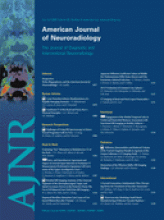Thank you for your insightful comments on our recent diffusion tractography study of partial agenesis of the corpus callosum1 and for bringing to our attention your prior work on MR imaging of partial callosal agenesis.2 Our own structural MR imaging analysis showing significant variation in the size and location of callosal fragments in individuals with partial agenesis is in good agreement with your previous results. Taken together, they provide strong evidence that callosal fragments in individuals with partial callosal agenesis do not represent the incomplete growth of a normal callosum.
Our study supported and extended this hypothesis by using diffusion tensor imaging (DTI) and high angular resolution diffusion imaging to perform 3D tractography, a technique unavailable at the time of your study. We determined the connectivity of axons passing through each callosal fragment and compared the pattern of connectivity with what would be expected based on the location of the fragment alone. We thus demonstrated not only that the positions of callosal fragments are variable (as can be shown with conventional MR imaging) but that the connectivity through a callosal fragment is also variable and cannot be determined on the basis of its anatomic location. These results confirm, in human subjects, what was found in the mouse studies you cite using horseradish peroxidase track tracing.3,4
In reading your article, we found the breakdown of your results based on associated brain abnormalities, such as Chiari II or Dandy-Walker malformations, particularly interesting. Although 10 of all 25 subjects in your study demonstrated a callosal fragment corresponding to the position of a normal callosum, only 2 of 10 subjects without associated abnormalities had a fragment at a normal position. Our cohort was restricted to individuals with either no or minor associated abnormalities, and all 6 of our subjects had connectivity patterns different from what would be expected based on incomplete callosal growth. These results together suggest that subjects with partial agenesis without associated abnormalities are more likely to develop callosal fragments unexplainable by incomplete callosal growth. Because individuals with associated brain abnormalities likely have different underlying causes of callosal dysgenesis, this result is perhaps not surprising. However, a more comprehensive classification of callosal morphology and connectivity based on etiology could yield significant insight into the developmental mechanisms of callosal dysgenesis. This awaits further investigation in larger cohorts.
- Copyright © American Society of Neuroradiology












